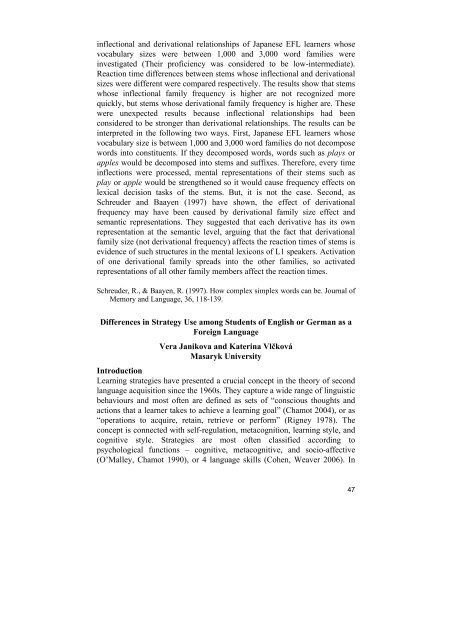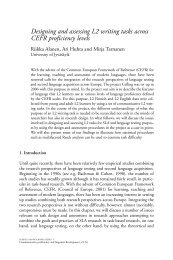BOOK OF ABSTRACTS - EUROSLA
BOOK OF ABSTRACTS - EUROSLA
BOOK OF ABSTRACTS - EUROSLA
You also want an ePaper? Increase the reach of your titles
YUMPU automatically turns print PDFs into web optimized ePapers that Google loves.
inflectional and derivational relationships of Japanese EFL learners whose<br />
vocabulary sizes were between 1,000 and 3,000 word families were<br />
investigated (Their proficiency was considered to be low-intermediate).<br />
Reaction time differences between stems whose inflectional and derivational<br />
sizes were different were compared respectively. The results show that stems<br />
whose inflectional family frequency is higher are not recognized more<br />
quickly, but stems whose derivational family frequency is higher are. These<br />
were unexpected results because inflectional relationships had been<br />
considered to be stronger than derivational relationships. The results can be<br />
interpreted in the following two ways. First, Japanese EFL learners whose<br />
vocabulary size is between 1,000 and 3,000 word families do not decompose<br />
words into constituents. If they decomposed words, words such as plays or<br />
apples would be decomposed into stems and suffixes. Therefore, every time<br />
inflections were processed, mental representations of their stems such as<br />
play or apple would be strengthened so it would cause frequency effects on<br />
lexical decision tasks of the stems. But, it is not the case. Second, as<br />
Schreuder and Baayen (1997) have shown, the effect of derivational<br />
frequency may have been caused by derivational family size effect and<br />
semantic representations. They suggested that each derivative has its own<br />
representation at the semantic level, arguing that the fact that derivational<br />
family size (not derivational frequency) affects the reaction times of stems is<br />
evidence of such structures in the mental lexicons of L1 speakers. Activation<br />
of one derivational family spreads into the other families, so activated<br />
representations of all other family members affect the reaction times.<br />
Schreuder, R., & Baayen, R. (1997). How complex simplex words can be. Journal of<br />
Memory and Language, 36, 118-139.<br />
Differences in Strategy Use among Students of English or German as a<br />
Foreign Language<br />
Vera Janikova and Katerina Vlčková<br />
Masaryk University<br />
Introduction<br />
Learning strategies have presented a crucial concept in the theory of second<br />
language acquisition since the 1960s. They capture a wide range of linguistic<br />
behaviours and most often are defined as sets of “conscious thoughts and<br />
actions that a learner takes to achieve a learning goal” (Chamot 2004), or as<br />
“operations to acquire, retain, retrieve or perform” (Rigney 1978). The<br />
concept is connected with self-regulation, metacognition, learning style, and<br />
cognitive style. Strategies are most often classified according to<br />
psychological functions – cognitive, metacognitive, and socio-affective<br />
(O’Malley, Chamot 1990), or 4 language skills (Cohen, Weaver 2006). In<br />
47



